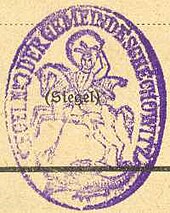Czechowice (Gliwice)
| Czechowice Schechowitz |
||
|---|---|---|
 Help on coat of arms |
|
|
| Basic data | ||
| State : | Poland | |
| Voivodeship : | Silesia | |
| Powiat : | District-free city | |
| District of: | Gliwice | |
| Geographic location : | 50 ° 22 ' N , 18 ° 38' E | |
| Height : | 230 m npm | |
| Residents : | 850 (2005) | |
| License plate : | SG | |
| Economy and Transport | ||
| Street : |
|
|
Czechowice (German: Schechowitz ) is a district of Gliwice (Gleiwitz). Czechowice had 850 inhabitants in 2005 and is located in the north of Gliwice. At Czechowice there is a quarry pond with the municipal recreation center Czechowice.
history
The place arose in the 13th century at the latest and was first mentioned in a document as "Cechowitz" in 1295–1305 in the Liber fundationis episcopatus Vratislaviensis ( Tithe Register of the Diocese of Breslau ). Schechowitz was created according to German law.
The place was mentioned in 1783 in the book Entries describing Silesia as Czechowi (t) z , was owned by the Baron von Wilczek, was in the Tost district of the Principality of Opole and had two farms, 135 inhabitants, 16 farmers, 15 gardeners and two cottagers and a Catholic Church. The church was a scrap wood church that caught fire and then fell apart. In 1818 the place was mentioned as Czechowitz . In 1865 Czechowitz consisted of a village and a farm. The buildings were scattered and the area ravine. At that time the village community had 15 farms, 18 gardeners and 18 cottagers, as well as a Kretschmer (innkeeper). The residents were parish and enrolled in Laband. The Vorwerk Czechowitz, which was also called Oberhof, had a subsidiary Vorwerk called Niederhof.
In the referendum in Upper Silesia on March 20, 1921, 114 people eligible to vote in place voted for Upper Silesia to remain with Germany and 465 for membership in Poland. After the division of Upper Silesia, Schechowitz remained with the German Empire . In 1936 the place was renamed Böhmswalde in the course of a wave of renaming during the Nazi era . Until 1945 the place was in the district of Tost-Gleiwitz .
In 1945 the formerly German town came under Polish administration and was then joined to the Silesian Voivodeship and renamed Czechowice in Poland . In 1950 the place came to the Katowice Voivodeship . In 1959, Czechowice became part of Łabędy and was named Łabędy 3 . 1964 Czechowice was incorporated together with Łabędy from the powiat Gliwicki to Gliwice. In 1999 the place became part of the new Silesian Voivodeship. In 2000 the school in the district was closed.
In the summer of 2017, archaeological excavations were carried out in the area of the former church. The medieval foundations of St. George's Church, coins and human skeletons were exposed.
Buildings and monuments
- The Nepomuk Chapel was built after the Georg chapel was demolished
- Memorial stone for the victims of both world wars
coat of arms
Old seals and community stamps from Schechowitz show St. George killing a dragon. St. George was the patron saint of the former village church.
traffic
Droga wojewódzka nr 901 runs through Czechowice. It connects u. a. Gliwice with Pyskowice .
Web links
Individual evidence
- ^ Johann Ernst Tramp: Additions to the Description of Silesia, Volume 2 , Brieg 1783
- ^ Geographical-statistical handbook on Silesia and the county of Glatz, Volume 2 , 1818
- ↑ Felix Triest: Topographisches Handbuch von Oberschlesien , Breslau 1865
- ^ Results of the referendum in Upper Silesia in 1921: Literature , table in digital form
- ↑ Gość Gliwice: Pracują archeolodzy i społecznicy





